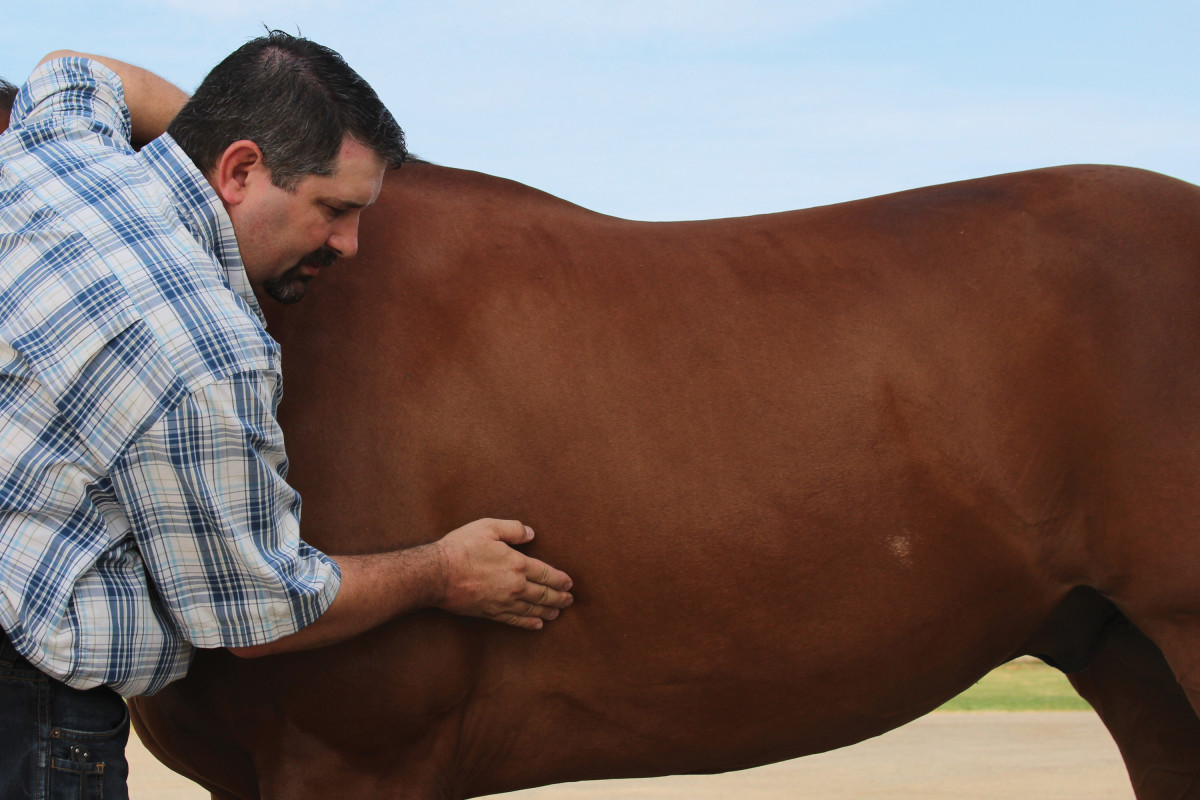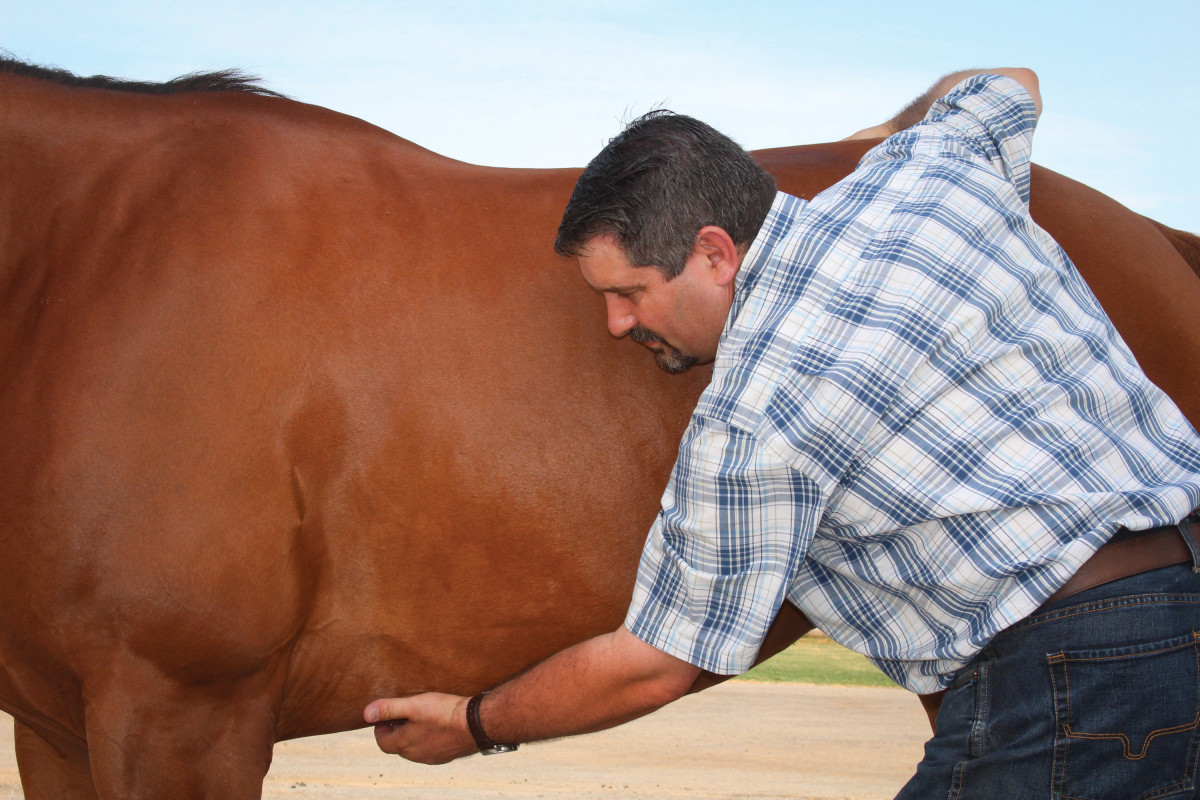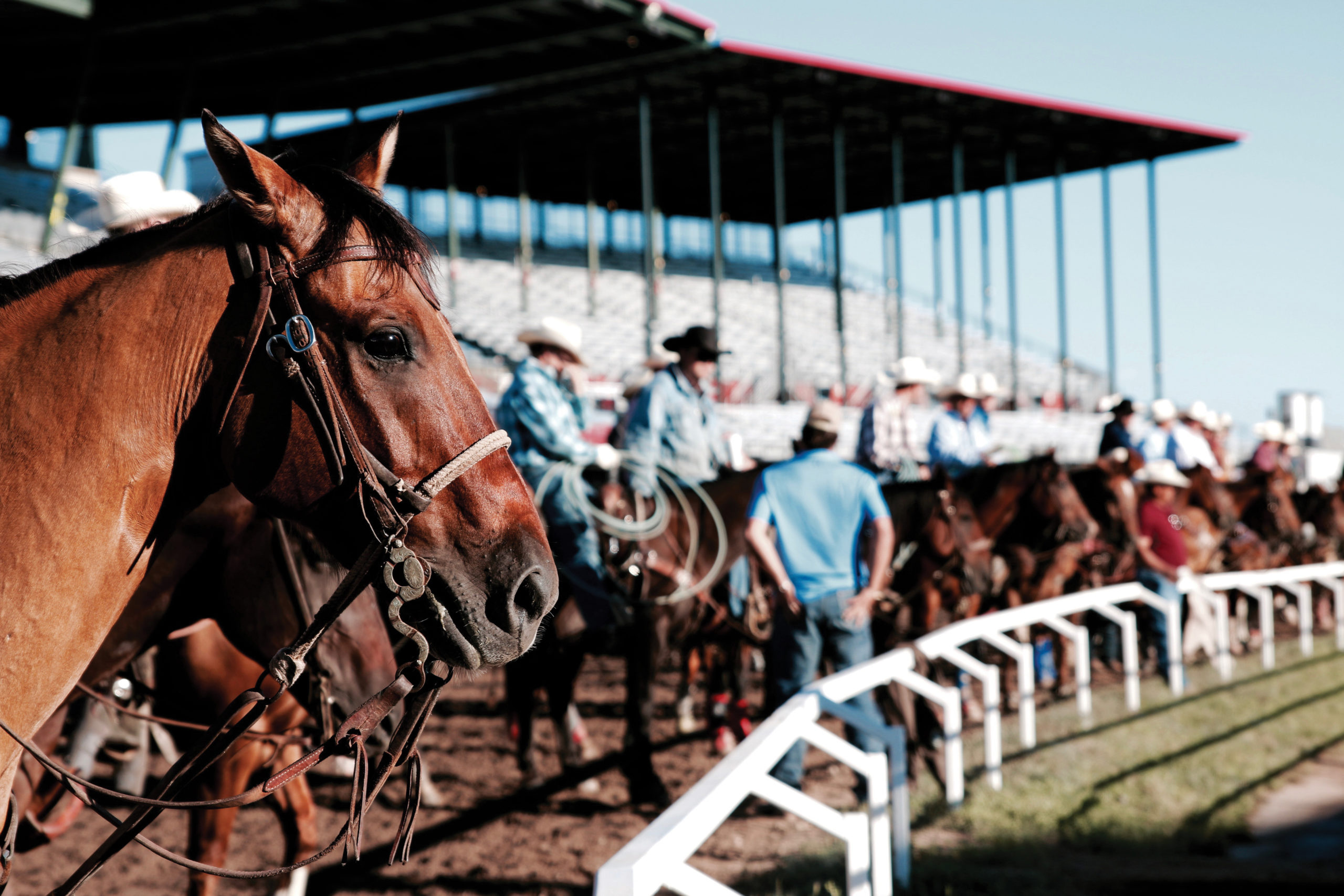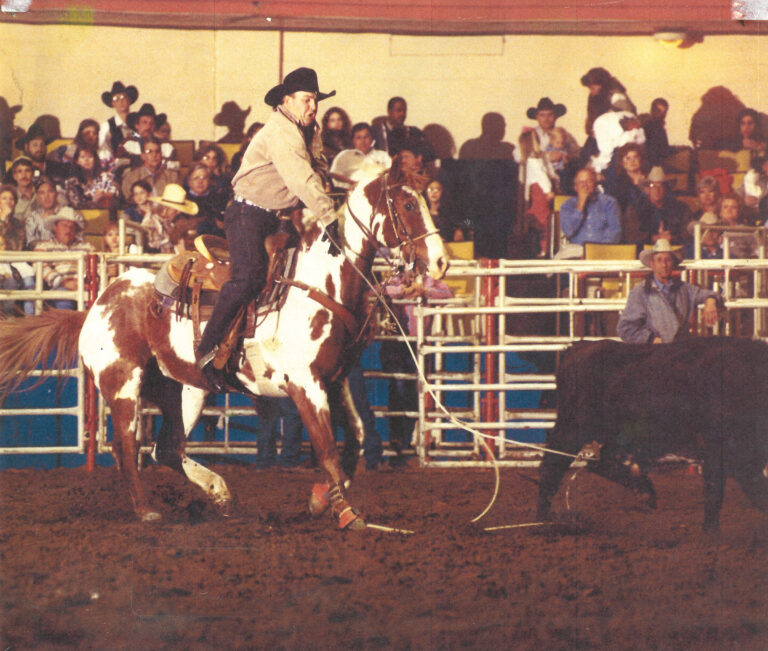At any given jackpot, ten horses are tied to a section of fence. Can you believe a staggering nine of them have irritated sores in their stomachs that could be making them bad in the box or unwilling to take the jerk?
It’s been 15 years since a study in the Journal of Equine Veterinary Science noted that up to 90% of performance horses have some kind of ulcer. It underscores our need to understand the causes, symptoms and treatments of ulcers.
Why do these sores form in the first place?
The equine stomach has two parts, according to Mark DePaolo, DVM, of Pilot Point, Texas. The upper third is like our esophagus, while the bottom two-thirds is more like our stomach, lined with glands that secrete acid, enzymes and mucous. We humans only secrete acid when smelling or eating food. But horses constantly produce acid and enzymes—up to 16 gallons of acidic fluid every 24 hours.
According to Dr. DePaolo, it takes as few as five days for an overly acidic stomach—without enough neutralization from saliva or feed—to cause lesions of the stomach lining and throughout the digestive tract. The upper part of the stomach is less protected and therefore more likely to develop sores.
Two-time NFR heeler Shay Carroll, a Colorado native now living in Texas, has had far too much experience with equine ulcers. The horses he’s had that were diagnosed by veterinarians didn’t want to keep their backs picked up to run and stop or didn’t really want to take the jerk. Or he noticed them not finishing all their feed or acting cinchy or even dipping their hay in water prior to eating.
“If your horse is acting up or not stopping correctly and you’ve had your vet check his hocks, stifles and teeth, ulcers are worth looking into,” Carroll said. “On Ulcergard, I’ve seen a horse’s attitude change within a week. If a horse had a constant stomachache and was always on edge, once it gets relief, it actually rides like it’s been aced [given the sedative acepromazine].”
Longtime heeler Doug Funk, DVM, whose son Matt roped horns at two NFRs, has also seen ulcer-stricken horses act hungry but stand away from the feeder, not eating, or be cinchy or even groan when being saddled or taking a jerk. If your horse is doing any of the above, acting grumpy when you show up at a roping or getting hot going into the box, it can’t hurt to check for ulcers.
Point Palpation


ULCER PROMOTERS
- Botfly larvae
- Disruption of colon’s pH level
- Medication
- Infrequent feedings
- Stall confinement
- High-grain diets
- Change of environment
POSSIBLE SYMPTOMS
- Loss of appetite
- Tail wringing
- Cinchiness
- Decreased performance
- Teeth grinding
- Gas; diarrhea
- Cribbing
Pinning it down
Ulcers can only be truly diagnosed by endoscopy. However, scoping is invasive to the horse, pricey, and not every veterinarian has a scope. Plus, it doesn’t allow views of intestinal or hindgut lesions.
You can use Dr. DePaolo’s point-palpation test (found at DePaoloEquineConcepts.com) to notice whether your horse pins its ears or tries to bite when you press the points located on the meridian closely associated with the horse’s digestive tract. Or you can try ulcer treatment and see if symptoms dissipate.
Most common medications focus on decreasing acid, but H2 antagonists aren’t always effective and need to be given several times a day. Other common medicines are proton pump inhibitors (PPIs), which block secretion of acid. The holy grail of these is omeprazole, which needs to be given for at least five straight days.
Another medicine, sucralfate, reacts with stomach acid to form a gel that can adhere to the surface of ulcers to protect them from further damage, thereby allowing healing. And a cost-effective treatment preferred lately is compounded or generic omeprazole. Just be aware that it can be broken down and made ineffective by stomach acid, so you should combine it with an acid buffer.
The only FDA-approved treatment for equine ulcers is Gastrogard, an omeprazole paste that should help ulcers heal within 28 days. The same company makes another omeprazole product, Ulcergard, designed for preventative use whenever your horse is under stress from hauling, competing, stall confinement or social regrouping. Carroll has faith in Gastrogard but said the much cheaper powder omeprazole has been just as effective, in his experience.
“If I think a horse may have ulcers, I’ll put it on omeprazole powder with ranitidine to see if it gets better, or I’ll also get the horse scoped,” Carroll said.
Dr. Funk likes compounded omeprazole, too. A good time for it is after your horse has had Bute for more than three days in a row, he said. That’s because pain relievers reduce blood to the digestive tract and disrupt acid-neutralizing mucous production. However, he also said that an even worse ulcer-causer than pain-relievers is simple equine anxiety.
Ironically, World Champion Header Turtle Powell and his wife, Molly, a 10-time NFR barrel racer, think having Bute and Banamine on hand to relieve the stress of a sore horse was a big factor in them never needing to treat for ulcers.
“We also bedded their stalls, unloaded and watered them every five hours when hauling, let their friends be with them and turned them out when we could,” Powell said.
Safeguarding your horse
While the use of omeprazole is advocated after pain relievers or while hauling or competing, it’s not for long-term use (no more than 30 days). Decreased stomach acid hurts your horse’s ability to break down and absorb certain minerals. Also, omeprazole doesn’t treat hindgut ulcers, which can happen when the colon’s pH level is disrupted. The best treatment for those is prevention, says Dr. DePaolo.
Prevention starts with consistent and frequent forage-heavy feedings. Long-stem alfalfa takes a lot of chewing and produces more saliva. Plus, feeding via a small-mesh hay net slows the rate of eating and prevents empty stomachs.
Frequent meals are even better when traveling, Dr. DePaolo said, with high-fiber hay available at all times and the opportunity to graze. Horses allowed to move will have a proven lower incidence of colic and ulcers than stall-bound horses. Also, exercise on an empty stomach can contribute to ulcers.
“I rode fat horses,” said Powell, one of the winningest jackpotters of this generation. “People gave me hell, but I always had a happy horse.”
When buying feed, read the ingredients. Dr. DePaolo suggests you avoid molasses, as well as grain including corn, oats and barley because it’s all broken down into sugar, increasing acid production and promoting ulcer formation. When lots of starchy grains are fed, the small intestine can’t digest them properly. The undigested portion passes into the hindgut, which is only designed to process fiber.
Then it gets bad. When undigested starch passes into the colon, the hindgut pH level shifts, which causes mucosal damage in the large intestine. You get lactic acid draining into the bloodstream from the hindgut, which can cause your horse to tie up, and the pH imbalance can cause endotoxins that can trigger colic, too.
If your horse needs more calories for energy than hay or pasture, Dr. DePaolo suggests alfalfa pellets. Hard keepers can also get soaked beet pulp or additional fat from rice bran or Renew Gold.
“We grew up hearing about ‘sweet feed’ and thought it was fine because horses loved corn, oats and barley,” said Molly. “But companies like Purina are using licorice flavoring instead of molasses and adding high fat oils and Omega 3 fatty acids. Turtle and I have taken tours at the Purina plant in St. Louis to learn about nutrition, because they spend millions on research.”
If you’re looking for an all-inclusive pelleted feed, go for the extruded kind. “Extruded” means that after ingredients are mixed and cooked, they’re popped into pellets by a drop in air pressure that causes starch molecules to explode. The process makes starches easier to digest and absorb.
Extra help
The official feed of the WSTR and USTRC, Total Equine, is alfalfa-based with virtually every vitamin and mineral a horse needs. Nutritionist and founder Harry Anderson hears from owners whose horses’ ulcers disappear on it. It’s about gut integrity, he said. Total Equine has no molasses or added sugar and is extruded so it has no raw starch to promote acid.
Additionally, it includes an extra-absorbable form of magnesium, which maximizes blood flow and helps control nerves. Available at TotatFeeds.com, Total Equine also contains a special seaweed ingredient that calms the nervous system and lowers overall anxiety, Anderson reported anecdotally. That’s in addition to the way it raises pH for better nutrient absorption and gut health. Fans include NFR switch-ender Bret Beach, along with many other team ropers and renowned horsemen Chris Cox and Craig Cameron.
When treating ulcers, Dr. DePaolo suggests also starting a daily digestive soother on the fourth or fifth day of treatment. He prefers products with ingredients like aloe vera, slippery elm bark, marshmallow root, prebiotics and probiotics. His product, Excel (available for order via his website), has all of the above, tastes good to horses and costs just $16 or $33 per month, depending on your horse’s needs.
“It has the two amino acids that help treat leaky gut syndrome, but is still affordable to use,” said Dr. DePaolo. “Ropers can use the minimal dose and just double it on days they’re going to a jackpot.”
For years, the Powells swore by Fastrack probiotic paste and electrolyte supplements, too. A good time to add these supplements is also whenever your horse has been sedated, vaccinated, wormed or given antibiotics or anti-inflammatories—all of which disrupt the gut’s microflora.
One supplement popular with ropers for ulcer treatment and prevention is Zesterra, launched by three-time NFR heeler Matt Zancanella, who tried a product he was sent to neutralize acid in the stomachs of cattle, and discovered it also raised the pH level in equine digestive tracts, which helps keep them “from getting burnt.” His team then did studies showing Zesterra healed ulcers and lowered cortisol levels in racehorses.
“We suggest giving Zesterra anytime you’ll stress the horse, and as a follow-up to Ulcergard and Gastrogard to keep acid down,” said Zancanella, who also offers mineral lick tubs containing Zesterra.
Because of the way it makes the gut less acidic, he said it’s great for weaned baby colts, and it makes his broodmares winter much easier and breed back better. The product, available at ProEarthAnimalHealth.com, is also favored by Carroll.
How Your Rope Horse Feeding Program Can Solve Your In-Arena Problems
“I had a colt I was seasoning that didn’t finish his feed and didn’t want to drink and looked drawed up all the time,” he said. “I combined omeprazole powder with Zesterra and it got him right back to drinking and eating and having a full look through the belly.”
Ulcers can have a drastic impact on your horse’s health and performance. Luckily, they’re also preventable.









